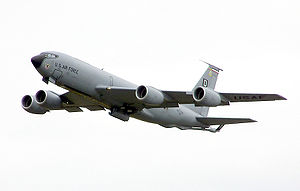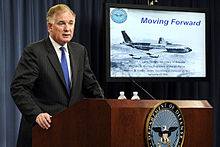KC-X Video - Picture

|
|
KC-X
KC-X program

Picture - A United States Air Force KC-135 tanker takes off in Gloucestershire, England. The winner of the KC-X program is slated to replace older KC-135s.
Project for: aerial refueling tanker aircraft
Proposals: Airbus A330 MRTT, Boeing KC-767, Antonov An-112KC
Prototypes: Boeing KC-767, Airbus A330 MRTT
Date concluded: 2011
Outcome: Round 1: EADS/Northrop Grumman KC-45 selected for production, but result protested
Round 2: Boeing KC-46 selected for production, no protest
Predecessor programs: Commercial Derivative Air Refueling Aircraft
Related programs: KC-Y, KC-Z
KC-X is the name of the United States Air Force program to procure its next-generation aerial refueling tanker aircraft. This aircraft is intended to replace some of the older Boeing KC-135 Stratotankers. The contest was for a production contract for 179 new tankers with estimated value of US$35 billion. The two contenders to replace the KC-135 aircraft were Boeing and EADS, following the elimination of US Aerospace, Inc.
The current KC-X program follows earlier attempts by the United States Air Force to procure a new tanker. A 2002 plan had the USAF leasing Boeing KC-767 tankers, followed by a 2003 modification where the USAF would buy most of the KC-767 aircraft and lease several more of them. Corruption investigations revealed wrongdoing in the award of the contract and the contract was canceled in 2005, setting the stage for the KC-X program.
The United States Air Force issued the KC-X request for proposal in January 2007, then selected the Northrop Grumman/EADS team and their Airbus A330-based tankers in February 2008. In June 2008, the U.S. Government Accountability Office sustained a protest by Boeing on the award of the contract. In July 2008, the U.S. Defense Department reopened the bidding process, but canceled the KC-X solicitation in September 2008. In September 2009, the USAF began the first steps toward accepting new bids. In March 2010, Northrop Grumman announced that it would pull out of the bidding process. Despite Northrop Grumman's withdrawal, EADS decided to remain in the ongoing competition alone. The Air Force selected Boeing's bid on 24 February 2011 and EADS declined to protest the award.
Background
The initial plan was to lease Boeing KC-767 tankers on a sole-source basis; Boeing is the only American company with the requisite industrial capability to manufacture large-body aircraft. As such, the KC-767 was initially selected in 2002 and in 2003 was awarded a US$20 billion contract to lease KC-767 tankers to replace the KC-135.
Led by Senator John McCain, several US government leaders protested the lease contract as wasteful and problematic. In response to the protests, the Air Force struck a compromise in November 2003, whereby it would purchase 80 KC-767 aircraft and lease 20 more.
Yet in December 2003, the Pentagon announced the project was to be frozen while an investigation of allegations of corruption by one if its former procurement staffers, Darleen Druyun (who had moved to Boeing in January 2003) was begun. Druyun pled guilty of criminal wrongdoing and was sentenced to nine months in jail for "negotiating a job with Boeing at the same time she was involved in contracts with the company". Additional fallout included the termination of CFO Michael M. Sears (who was later sentenced to four months in prison in 2005), the resignation of Boeing CEO Philip M. Condit, and the payment by Boeing of a $615 million fine in recompense for their actions related to the contract. In January 2006, the lease contract was formally canceled.
Proposals
Initial competition
The USAF then began the KC-X tanker replacement program. The DoD posted a request for proposal on 30 January 2007. The U.S. Air Force's main requirements are "fuel offload and range at least as great as the KC-135", airlift capability, ability to take on fuel in flight, and multi-point refueling capability.
Two manufacturers expressed interest in producing this aircraft. The team of Northrop Grumman and EADS/Airbus proposed a version of the Airbus A330 Multi Role Tanker Transport (MRTT), based on the Airbus A330-200 Boeing proposed a version of the KC-767, based on the Boeing 767
In February 2007, the Seattle Times commented on the pre-final designs: "Northrop has been viewed as the underdog, with a heavier, less fuel efficient aircraft. The Airbus tanker would have a maximum fuel capacity of 200,000 pounds. Northrop spokesman Randy Belote said Northrop's K-30 would tack on roughly 20 percent in fuel capacity."
Both competitors submitted their tanker proposals before the 12 April 2007 deadline. In September 2007, the USAF rejected having a mixed fleet new tankers from both Boeing and Northrop Grumman as being unfeasible because of increased costs in buying limited numbers of two types annually. The competitors submitted final revisions of their proposals to the U.S. Air Force on 3 January 2008. On 29 February 2008, the DoD announced their choice of the Northrop Grumman/EADS's KC-30.
In December 2007, it was announced that this aircraft will be designated the KC-45A regardless of which design wins the competition. The DoD anticipated that the KC-45A would start to enter service in 2013.
On 11 March 2008, Boeing filed a protest with the Government Accountability Office (GAO) of the award of the contract to the Northrop Grumman/EADS team. Boeing stated that there are certain aspects of the USAF evaluation process that have given it grounds to appeal. Their protest was upheld by the GAO on 18 June 2008, who recommended that the Air Force rebid the contract.
Expedited recompetition
On 9 July 2008, the Defense Secretary Robert Gates put the tanker contract in an "expedited recompetition" with Defense Undersecretary John Young in charge of the selection process instead of the Air Force. A draft of the revised RFP was provided to the contractors on 6 August 2008 for comments with the revised RFP to be finalized by mid-August. Proposals would be due in October 2008 and selection was to be done by the end of 2008. In mid-August, there was speculation that Boeing was considering a "no bid" position. On 21 August 2008 Boeing asked the DoD for an additional four months to submit a proposal centered on a larger aircraft, but they opposed further delay. Then on 10 September 2008, Defense Secretary Robert Gates decided that the new competition could not be fairly completed before the end of 2008. The DoD canceled the request for proposals and delayed the decision on when to issue another request until the new presidential administration was in office.
Round three

Picture - Deputy Secretary of Defense William Lynn, speaks about KC-X at a press conference at the Pentagon on 24 September 2009.
On 16 September 2009, Secretary Gates announced a renewed effort for the KC-X program. The selection process will be under the Air Force with a "robust oversight role" by the Office of the Secretary of Defense to prevent a repeated failure. On 25 September 2009 the USAF issued a draft request for proposals (RFP) seeking comments for the official tanker replacement RFP. The RFP for a fixed price contract specified 373 requirements for the new plane, and stated that the price of each tanker would be adjusted to reflect how much it would cost to operate over 40 years and how well it would meet various war-fighting needs. The initial contract would be for 179 aircraft for $35 billion. Northrop Grumman/EADS team claimed the requirement was advantaging Boeing and threatened to withdraw from the competition on 1 December 2009.
The fiscal 2011 Defense Department budget relegates $864 million in research and development money. A contract award was expected in summer 2010. On 24 February 2010, the US Air Force released the revised request for proposal (RFP) for KC-X. The RFP calls for the KC-X tanker to first fly in 2012 and aircraft deliveries to begin in 2013.
On 8 March 2010, Northrop Grumman followed through with their earlier threat and decided to not submit a bid for the KC-X tanker stating that they believe the new evaluation methodology favors Boeing's smaller tanker. EADS, however announced on 20 April 2010, that it was re-entering the competition on a stand-alone basis and intended to bid the KC-30 with final assembly to take place in Mobile, Alabama as planned under its prior teaming arrangement with Northrop Grumman. On 18 June 2010, the USAF announced that the decision would be delayed until November 2010.
On 1 July 2010, a surprise third bidder, consisting of the team of US Aerospace and the Ukrainian manufacturer Antonov announced its intention to bid in the competition. The two firms announced that they would be interested in supplying up to three types of aircraft to the United States Air Force. The types reportedly being offered are the four-engined An-124 and a twin-engined variant of the aircraft, the An-122. The third aircraft to be offered is known as the An-112. The An-112 tanker is a version of the Antonov An-70, except with two jet engines. This tanker was proposed in the team's bid.
By 9 July 2010 bids from Boeing, EADS and US Aerospace/Antonov were submitted to the Air Force. However, the Air Force rejected the US Aerospace bid for allegedly arriving 5 minutes after the deadline, which US Aerospace disputes. US Aerospace filed separate protests with the U.S. Government Accountability Office (GAO) on 2 August and 1 September. The U.S. Air Force proceeded with source selection while GAO investigated. The GAO dismissed U.S. Aerospace’s protest on 6 October.
In November 2010 the USAF made yet another mistake by sending technical reviews of the other side's bids to each of the two remaining teams. However the usual new delay in awarding the contract was said to be unrelated. Loren B. Thompson, of the libertarian think tank Lexington Institute, said that key meetings the Air Force was expected to hold with the two bidders in January must be put off to prepare for Senate hearings, further delaying an award of the contract.
Boeing and EADS submitted their final bids on 10 February 2011. On 24 February 2011, Boeing's KC-767 proposal was selected as the winning offer. The tanker will be named the KC-46A.
EADS North America chairman Ralph Crosby declined to protest the award saying that Boeing's bid was "very, very, very aggressive" and carried a high risk of losing money for the company.
Specifications
There were three different bids proposed in July 2010. EADS proposed the Airbus A330 MRRT/KC-30, Boeing proposed the KC-767, while the Antonov/US Aerospace team's bid was the An-112KC. Specifications of these aircraft are listed in the table below.
Sources: Northrop Grumman KC-30, Airbus A330, KC-767 Advanced Tanker, Boeing 767, Civil Aircraft, A330 FSTA An-112KC
Future Strategic Tanker Aircraft
KC-X Pictures
More aircraft.
Source: WikiPedia